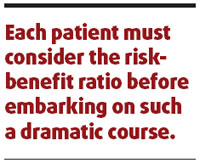Advances in facial reconstruction
By Iain Hutchison (China Daily)
Updated: 2008-03-06 07:26
Updated: 2008-03-06 07:26
What happens to our self-belief and society's perception of us when our faces change through injury or disease? This depends not only on the severity of the damage but also on factors such as how the damage occurred, the age when it developed and the victim support network available.
The increasing importance of the face to self-esteem has resulted in a burgeoning desire for treatments to convert faces to the Hellenic norm and arrest the ravages of aging. Emotional and financial success is often associated with youthful vigor rather than elderly experience.
We can think of the face as an underlying skeletal scaffold made up of highly complex bony architecture with air sinuses to lighten our heads so we do not drag them along the floor.
Within these bones we have teeth, which hold our lips and cheeks out in an attractive fashion. Draped over this bone is skin with highly complicated three-dimensional patterns. Skin has different texture, thickness and hair- bearing capacity at various sites on the face.

Surgical advances have achieved the ability to mimic the face's underlying bony landmarks, but we cannot use skin from other sites of the body to exactly mimic facial skin.
Therefore the face transplant carried out by Professors Devauchelle and Testelin in 2005, replacing the skin of a patient's nose, lips and cheek, was a major breakthrough in surgical reconstruction of the facial soft tissues.
It captured the public imagination, not only because of the dramatic physical result but also because it suggested the possibility of great advances in cosmetic surgery.
However, the public did not consider the immense risks of the immunosuppressant drug therapy necessary to prevent rejection of the transplant from a dead donor. These drugs cause muscle-wasting, bone loss and spotty skin, and increase the risks of malignant tumors developing. So there is no current role for face transplantation in cosmetic surgery.
Face transplants clearly have a role to play for severe burn victims, but they are not life-saving operations. Each patient must consider the risk-benefit ratio before embarking on such a dramatic course.
There are also psychological effects caused by carrying around somebody else's facial skin - for the patient, their family and the family of the person whose skin was donated.
Researchers are working on growing spare body parts from a patient's own stem cells. The potential for "tissue engineering" is immense, because there is no need for immunosuppressants. This is still in the realm of science fiction, but could become reality within a decade.
The Guardian
(China Daily 03/06/2008 page10)
|
|
|
|
|
|